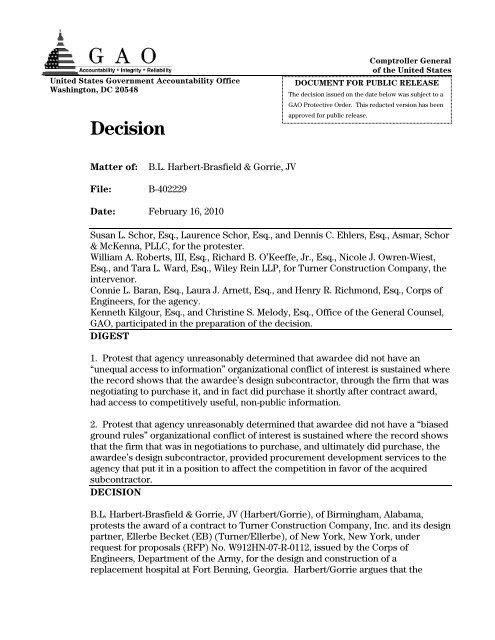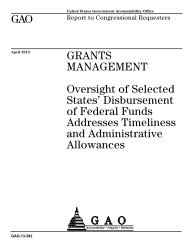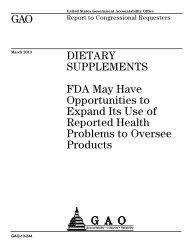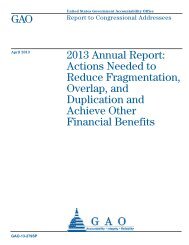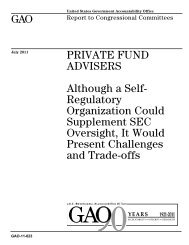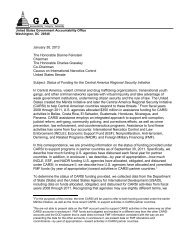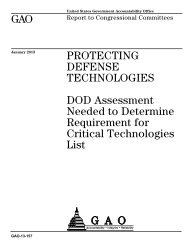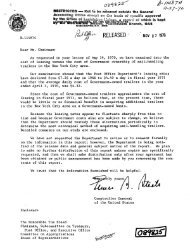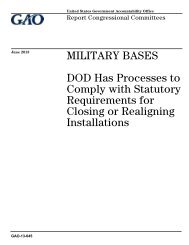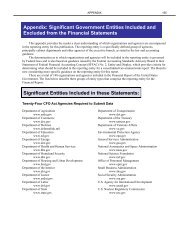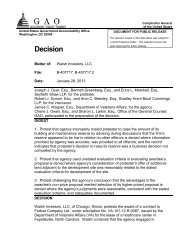B-402229 B.L. Harbert-Brasfield & Gorrie, JV - US Government ...
B-402229 B.L. Harbert-Brasfield & Gorrie, JV - US Government ...
B-402229 B.L. Harbert-Brasfield & Gorrie, JV - US Government ...
You also want an ePaper? Increase the reach of your titles
YUMPU automatically turns print PDFs into web optimized ePapers that Google loves.
United States <strong>Government</strong> Accountability Office<br />
Washington, DC 20548<br />
Decision<br />
Comptroller General<br />
of the United States<br />
DOCUMENT FOR PUBLIC RELEASE<br />
The decision issued on the date below was subject to a<br />
GAO Protective Order. This redacted version has been<br />
approved for public release.<br />
Matter of:<br />
B.L. <strong>Harbert</strong>-<strong>Brasfield</strong> & <strong>Gorrie</strong>, <strong>JV</strong><br />
File: B-<strong>402229</strong><br />
Date: February 16, 2010<br />
Susan L. Schor, Esq., Laurence Schor, Esq., and Dennis C. Ehlers, Esq., Asmar, Schor<br />
& McKenna, PLLC, for the protester.<br />
William A. Roberts, III, Esq., Richard B. O’Keeffe, Jr., Esq., Nicole J. Owren-Wiest,<br />
Esq., and Tara L. Ward, Esq., Wiley Rein LLP, for Turner Construction Company, the<br />
intervenor.<br />
Connie L. Baran, Esq., Laura J. Arnett, Esq., and Henry R. Richmond, Esq., Corps of<br />
Engineers, for the agency.<br />
Kenneth Kilgour, Esq., and Christine S. Melody, Esq., Office of the General Counsel,<br />
GAO, participated in the preparation of the decision.<br />
DIGEST<br />
1. Protest that agency unreasonably determined that awardee did not have an<br />
“unequal access to information” organizational conflict of interest is sustained where<br />
the record shows that the awardee’s design subcontractor, through the firm that was<br />
negotiating to purchase it, and in fact did purchase it shortly after contract award,<br />
had access to competitively useful, non-public information.<br />
2. Protest that agency unreasonably determined that awardee did not have a “biased<br />
ground rules” organizational conflict of interest is sustained where the record shows<br />
that the firm that was in negotiations to purchase, and ultimately did purchase, the<br />
awardee’s design subcontractor, provided procurement development services to the<br />
agency that put it in a position to affect the competition in favor of the acquired<br />
subcontractor.<br />
DECISION<br />
B.L. <strong>Harbert</strong>-<strong>Brasfield</strong> & <strong>Gorrie</strong>, <strong>JV</strong> (<strong>Harbert</strong>/<strong>Gorrie</strong>), of Birmingham, Alabama,<br />
protests the award of a contract to Turner Construction Company, Inc. and its design<br />
partner, Ellerbe Becket (EB) (Turner/Ellerbe), of New York, New York, under<br />
request for proposals (RFP) No. W912HN-07-R-0112, issued by the Corps of<br />
Engineers, Department of the Army, for the design and construction of a<br />
replacement hospital at Fort Benning, Georgia. <strong>Harbert</strong>/<strong>Gorrie</strong> argues that the
agency unreasonably concluded that Turner/Ellerbe did not have or properly<br />
mitigated organizational conflicts of interest.<br />
We sustain the protest.<br />
BACKGROUND<br />
The RFP contemplated a design/build contract for the design and construction of an<br />
approximately 700,000 square-foot replacement hospital at Fort Benning, Georgia.<br />
The project required site work and the design and construction of the facility and the<br />
utilities infrastructure. The procurement was conducted in two phases; under<br />
Phase I, the agency would evaluate offerors’ past performance and technical<br />
capabilities. The agency then would select up to three of the most highly-rated<br />
offerors to receive the technical requirements package and provide technical and<br />
price proposals for evaluation under Phase II. Four firms responded to the Phase I<br />
solicitation. Ultimately, the agency selected McCarthy/Hunt, a Joint Venture,<br />
Turner/Ellerbe, and <strong>Harbert</strong>/<strong>Gorrie</strong> to participate in Phase II.<br />
In June 2007, the agency awarded a contract to HSMM/HOK Martin Hospital Joint<br />
Venture (HSMM/HOK <strong>JV</strong>), which was to assist the agency with the preparation of<br />
both the design concept for the hospital and a technical review of the proposals<br />
submitted. In May 2008, HSMM/HOK <strong>JV</strong>’s parent company, AECOM Technology<br />
Corporation (AECOM), executed a confidentiality agreement with EB in support of<br />
entering into negotiations for the possible acquisition of EB. 1<br />
On June 24, 2008, the<br />
agency issued the Phase I solicitation for the design/build contract. In July 2008,<br />
additional funding allowed the agency to expand the scope of the project from an<br />
addition to a replacement hospital.<br />
The Corps held an industry forum in August 2008 to inform the public and potential<br />
offerors about the upcoming contract. An AECOM senior vice president in charge of<br />
HSMM/HOK <strong>JV</strong> attended the forum and noticed that EB had expressed an interest in<br />
the project; according to the senior vice president, he knew that AECOM had been in<br />
confidential negotiations to acquire EB since July 2008. After the forum, the<br />
principal asked his AECOM supervisor about the potential for a conflict of interest if<br />
AECOM acquired EB, but the supervisor indicated that negotiations with EB “had<br />
not been productive.” AR, Tab 4A, Declaration of AECOM Senior Vice President<br />
at 6. On this record, this was the first awareness by an AECOM employee that<br />
1<br />
The record is unclear as to whether the two firms merged or AECOM acquired EB.<br />
Compare Agency Report (AR), Memorandum of Law at 9 (noting that “[o]n 26<br />
October 2009, AECOM and EB publicly announced the acquisition of EB by<br />
AECOM.”) with Intervenor’s Comments on the AR at 5 (noting that “as of mid-<br />
September 2009, the AECOM/EB merger was still far from a done deal.”) (emphasis<br />
added). For purposes of the decision here, the distinction is not material.<br />
Page 2 B-<strong>402229</strong>
there might be a conflict of interest, given that AECOM was in negotiations to<br />
purchase a firm that had an interest in the procurement on which AECOM was<br />
advising the agency. AECOM did not communicate any concern to the agency.<br />
Within a few weeks of the forum, the AECOM senior vice president recalled, he<br />
learned that AECOM’s negotiations with EB had been “suspended,” and he<br />
consequently “was no longer concerned about any potential conflict of interest and<br />
did not raise the issue further with the Agency.” 2 Id. at 7.<br />
The agency’s senior project manager for this procurement states that, in February<br />
2009, he and the AECOM senior vice president exchanged emails regarding potential<br />
organizational conflicts of interest with the offerors on the design/build contract.<br />
According to the senior project manager, the AECOM senior vice president reported<br />
to him that he had “inquired with several offices involved in the HSMM/HOK <strong>JV</strong> and<br />
reported only teaming relationships.” AR, Tab 3, Declaration of Senior Project<br />
Manager at 10. The agency made no further inquiry regarding these teaming<br />
arrangements.<br />
On or about April 2009, according to the AECOM senior vice president, AECOM<br />
concluded its work preparing the Phase II Technical Provisions of the solicitation.<br />
He states that, to the best of his knowledge, AECOM was not in negotiations with EB<br />
at that time. AR, Tab 4a, Declaration of AECOM Senior Vice President at 8.<br />
Contracting Officer’s Contemporaneous Assessment of the Organizational Conflicts<br />
of Interest<br />
Below is the contracting officer’s account of when she first learned of AECOM’s<br />
negotiations to purchase EB, and her response.<br />
-- On 21 July 2009, [the agency program manager] scheduled a meeting<br />
with me to discuss information from [the senior vice president] of<br />
AECOM. [The AECOM senior vice president] informed me that AECOM<br />
was in negotiations with one of the offerors’ subcontractors. [He]<br />
indicated he was bound by an AECOM non-disclosure agreement and<br />
could not disclose the name of the subcontractor. [The senior vice<br />
president] indicated that he was the only person on the AECOM/HOK<br />
Technical Evaluation Team who was aware of the confidential<br />
negotiations with the subcontractor.<br />
-- I had no information to indicate which subcontractor was the subject<br />
of [his] potential conflict. I considered the fact that AECOM’s<br />
2<br />
Inasmuch as the record contains no prior communication between the agency and<br />
AECOM concerning the negotiations, it is unclear what the AECOM senior vice<br />
president meant by “further” raise.<br />
Page 3 B-<strong>402229</strong>
negotiations were with a potential subcontractor for an offeror, not an<br />
offeror itself. I discussed the Source Selection Participation<br />
Agreements signed by the four AECOM employees with [him]. None of<br />
the Agreements revealed any potential conflict. I determined that [he]<br />
had not reviewed the proposals and that his recusal from any<br />
involvement with the Technical Review Board would avoid any<br />
potential conflict of interest.<br />
-- On 21 July 2009, [he] prepared a Memorandum for Record<br />
memorializing the meeting and the events of 20 July 2009. 3<br />
Contracting Officer’s Statement of Facts at 2-3. This exchange took place nearly<br />
1 year after AECOM was first aware that the firm it was interested in purchasing, or<br />
merging with, was the design subcontractor to a firm competing in a design/build<br />
acquisition on which AECOM was advising the agency. The contracting officer did<br />
not mention that the information she received from the AECOM senior vice<br />
president indicated that AECOM’s interest in purchasing EB dated from before the<br />
industry forum, and that AECOM learned of the possibility of a conflict of interest at<br />
the industry forum. The memorandum prepared by the AECOM senior vice<br />
president memorializing this meeting was also sent to agency counsel. AR, Tab 4a,<br />
Declaration of AECOM Senior Vice President, Exh. A.<br />
The Technical Review Board, with HSMM/HOK <strong>JV</strong>’s participation and support,<br />
completed its work in July 2009, and on or about August 24, 2009, the source<br />
selection authority reviewed the source selection evaluation board’s<br />
recommendation and decided to award the contract to Turner based on its proposal,<br />
which included the services of EB as a subcontractor. The Corps made the award<br />
September 28, 2009. According to Turner, EB’s directors approved the merger with<br />
AECOM on October 7, 2009, and obtained shareholder approval for the merger on<br />
October 22. EB announced the merger on October 23, 2009. This protest followed.<br />
Organizational Conflicts of Interest<br />
Contracting officials are to avoid, neutralize or mitigate potential significant conflicts<br />
of interest so as to prevent unfair competitive advantage or the existence of<br />
conflicting roles that might impair a contractor’s objectivity. Federal Acquisition<br />
Regulation (FAR ) §§ 9.504(a), 9.505.<br />
The responsibility for determining whether an actual or apparent conflict of interest<br />
will arise, and to what extent the firm should be excluded from the competition, rests<br />
with the contracting agency. Aetna Gov’t Health Plans, Inc.; Foundation Health Fed.<br />
3<br />
It is not clear from the contracting officer’s statement of facts to what events of<br />
July 20 she is referring. We assume the intended reference is to the events of July 21.<br />
Page 4 B-<strong>402229</strong>
Servs., Inc., B-254397.15 et al., July 27, 1995, 95-2 CPD 129 at 12. Because conflicts<br />
may arise in factual situations not expressly described in the relevant FAR sections,<br />
the regulation advises contracting officers to examine each situation individually and<br />
to exercise “common sense, good judgment, and sound discretion” in assessing<br />
whether a significant potential conflict exists and in developing an appropriate way to<br />
resolve it. FAR § 9.505. We will not overturn the agency’s determination except<br />
where it is shown to be unreasonable. Aetna Gov’t Health Plans, Inc.; Foundation<br />
Health Fed. Servs., Inc., supra.<br />
The situations in which organizational conflicts of interest arise, as addressed in FAR<br />
subpart 9.5 and the decisions of our Office, can be broadly categorized into three<br />
groups. The first group consists of situations in which a firm 4 has access to nonpublic<br />
information as part of its performance of a government contract and where that<br />
information may provide the firm a competitive advantage in a later competition for a<br />
government contract. FAR § 9.505-4. In these “unequal access to information” cases,<br />
the concern is limited to the risk of the firm gaining a competitive advantage; there is<br />
no issue of bias.<br />
The second group consists of situations in which a firm, as part of its performance of a<br />
government contract, has in some sense set the ground rules for another government<br />
contract by, for example, writing the statement of work or the specifications. In these<br />
“biased ground rules” cases, the primary concern is that the firm could skew the<br />
competition, whether intentionally or not, in favor of itself. FAR §§ 9.505-1, 9.505-2.<br />
These situations may also involve a concern that the firm, by virtue of its special<br />
knowledge of the agency’s future requirements, would have an unfair advantage in the<br />
competition for those requirements. 5<br />
Aetna Gov’t Health Plans, Inc.; Foundation<br />
Health Fed. Servs., Inc., supra at 13.<br />
Relationship Between AECOM and EB<br />
As a preliminary matter, the intervenor’s argument that there were no organizational<br />
conflicts of interests rests, in large part, on its assertion that the relationship<br />
between AECOM and EB was too attenuated to give rise to an organizational conflict<br />
of interest until the acquisition was completed. We disagree. As the cases cited by<br />
4<br />
While FAR subpart 9.5 does not explicitly address the role of affiliates in the<br />
various types of organizational conflicts of interest, there is no basis to distinguish<br />
between a firm and its affiliates, at least where concerns about potentially biased<br />
ground rules and impaired objectivity are at issue. Id. at 13.<br />
5<br />
The third and final type of organizational conflict of interest is found in cases where<br />
a firm’s work under one government contract could entail its evaluating itself, either<br />
through an assessment of performance under another contract or an evaluation of<br />
proposals. FAR § 9.505-3. The protester does not argue that there was this type of<br />
“impaired objectivity” conflict here.<br />
Page 5 B-<strong>402229</strong>
Turner/Ellerbe in support of its argument indicate, the nature and extent of the<br />
relationship between the firms are relevant to determining the existence of a conflict<br />
of interest. 6 See L-3 Servs., Inc., B-400134.11, B-400134.12, Sept. 3, 2009, 2009 CPD <br />
171 at 14-15; American Mgmt. Sys., Inc., B-285645, Sept. 8, 2000, 2000 CPD 163 at 5-<br />
6; Professional Gunsmithing Inc., B-279048.2, Aug. 24, 1998, 98-2 CPD 49 at 3-4;<br />
International Mgmt. and Commc’ns Corp., B-272456, Oct. 23, 1996, 96-2 CPD 156 at<br />
4-5. Here, in our view, the record shows that, as early as August 2008, AECOM’s and<br />
EB’s interests effectively were aligned as a result of the merger/acquisition<br />
discussions sufficient to present at least a potential organizational conflict of<br />
interest. The fact that negotiations between the firms may not have been<br />
continuous, or may have stretched over an extended period of time, does not allay<br />
the potential conflict. The record shows that the negotiations occurred during the<br />
active phases of this procurement. Under these circumstances, we think the<br />
relationship between the firms was sufficiently close to give rise to an organizational<br />
conflict of interest.<br />
Allegations Arising Out of AECOM’s Participation in the Procurement Planning Work<br />
• Unequal Access to Information<br />
The protester asserts that the agency unreasonably concluded that Turner/Ellerbe did<br />
not have an unequal access to information organizational conflict of interest or<br />
properly mitigated it.<br />
In order to ensure that the agency has acted in a manner consistent with the FAR,<br />
contracting officers are required to give meaningful, deliberate consideration to<br />
information that may shed light on potential organizational conflicts of interest.<br />
Toward that end, agencies must not limit their consideration only to information that<br />
may have been furnished by a firm. The Analysis Group, LLC, B-401726, B-401726.2,<br />
Nov. 13, 2009, 2009 CPD 237 at 5. Where a prospective contractor faces a potential<br />
unequal access to information organizational conflict of interest, the conflict may be<br />
mitigated through the implementation of an effective mitigation plan. Axiom Res.<br />
Mgmt., Inc., B-298870.3, B-298870.4, July 12, 2007, 2007 CPD 117 at 8-9. An agency’s<br />
reliance on a contractor’s self-assessment of whether an organizational conflict of<br />
interest exists or a contractor’s unilateral efforts to implement a mitigation plan,<br />
however, is inconsistent with the FAR. L-3 Servs., Inc., supra at 12; Johnson Controls<br />
World Servs., Inc., B-286714.2, Feb. 13, 2001, 2001 CPD 20 at 8. In other words, an<br />
6<br />
Our case law is consistent with the FAR, which defines “organizational conflict of<br />
interest” as meaning that because of other activities or relationships with other<br />
persons, a person is unable or potentially unable to render impartial assistance or<br />
advice to the <strong>Government</strong>, or the person’s objectivity in performing the contract work<br />
is or might be impaired, or a person has an unfair competitive advantage.” FAR<br />
§ 2.101.<br />
Page 6 B-<strong>402229</strong>
agency may not, in effect, delegate to the contractor itself complete responsibility for<br />
identifying potential organizational conflicts of interest, The Analysis Group, LLC,<br />
supra, or mitigating them. Johnson Controls World Servs., Inc., supra.<br />
Competitively useful information giving rise to an unequal access to information<br />
organizational conflict of interest includes proprietary information beyond offerors’<br />
proposals, such as source selection information and insights into a solicitation’s<br />
requirements. As discussed below, the record in this protest shows that AECOM, as<br />
the design contractor, was familiar with the details of the procurement. Access to<br />
such information gives rise to an unequal access to information organizational conflict<br />
of interest. See L-3 Servs., Inc., supra at 11.<br />
AECOM’s assistant general counsel, who advised AECOM in its negotiations to<br />
purchase EB, states:<br />
AECOM was required to maintain the confidentiality of all EB<br />
proprietary information and limit its disclosure within AECOM (and to<br />
agents of AECOM) on a “need to know” basis. Further, the<br />
confidentiality agreement expressly prohibited AECOM and EB from<br />
disclosing to any third party, without prior written consent, the fact that<br />
any confidential information had been exchanged. . . . To maintain the<br />
confidentiality of the parties’ discussions, the project would be referred<br />
to by its code “Project PACE” designation.<br />
Intervenor’s Comments on the AR, Exh. 2, Decl. of AECOM Assistant General<br />
Counsel at 5. This is the clearest statement in the record of the precautions taken<br />
by AECOM to ensure that information regarding its discussions with EB was not<br />
widely disclosed.<br />
AECOM’s efforts are deficient in several respects. There is no indication as to how<br />
many employees fit the “need to know” category, who they were, or how their need to<br />
know was determined. The assistant general counsel estimated that approximately<br />
25 to 30 personnel participated in the initial due diligence review, id. at 10, and<br />
approximately the same number of personnel, and approximately the same<br />
personnel, conducted a second review. Id. at 16. Five AECOM employees, who<br />
may not be included in the approximately 25 to 30, attended a briefing hosted by EB<br />
management, id. at 8, and the AECOM directors--an undetermined number of<br />
individuals--were also aware of the negotiations. However many AECOM employees<br />
fit the definition of “need to know,” the record contains no evidence of an effective<br />
plan, that was disclosed to and approved by the contracting officer and subject to<br />
monitoring by her, to ensure that information regarding AECOM’s plans to acquire EB<br />
was kept confidential.<br />
With respect to the other key factual element of the analysis here--the AECOM<br />
employees’ work on the design contract--the record is similarly lacking with regard to<br />
evidence of a plan to prevent disclosure to EB of competitively useful information<br />
Page 7 B-<strong>402229</strong>
derived from that work. In this regard, the agency identified 49 employees who<br />
worked on the design contract and who thus may have had access to competitively<br />
useful information. After the protest was filed, the agency obtained and submitted<br />
declarations from 42 of them; each declaration states that the individual did not have<br />
any knowledge of the acquisition negotiations and had no reason to, and made no<br />
attempt to, improperly influence the procurement. Only one declarant expressly<br />
stated that he did not discuss the procurement with anyone at EB. Of the 49<br />
employees identified by the agency, seven did not submit any declarations. In<br />
addition, while presumably all of the 49 used e-mail in their work assisting the<br />
agency, there is no mention in the declarations (or evidence elsewhere in the record)<br />
of specific efforts to limit access by others to such email. 7<br />
The agency asserts that, to the extent that AECOM had access to competitively useful<br />
information through its work on the design contract, that information was fully<br />
disclosed to other offerors. Moreover, the agency argues that the open-ended nature<br />
of the procurement prevented AECOM from being able to supply EB with<br />
competitively useful information. In our view, it was precisely the breadth of the<br />
discretion left to the offerors in the Phase II competition that would have made any<br />
competitively useful, non-public information known to AECOM valuable to EB. To<br />
illustrate: had the competition been for an automobile, with a particular carrying<br />
capacity, towing capacity, and performance characteristics, there would likely have<br />
been a minimal chance that AECOM would have competitively useful information; the<br />
specifications, if not the precise vehicle, would be largely established and<br />
communicated to all the offerors on an equal basis through the solicitation. In such a<br />
situation, the range of possible responses would be relatively limited. In this<br />
procurement, in contrast, the requirement was to design and build a replacement<br />
hospital of 700,000 square feet costing several hundred million dollars. AECOM was in<br />
a position to obtain information regarding the agency’s priorities, preferences, and<br />
dislikes relating to this broadly defined project. AECOM knew what the agency<br />
communicated to the offerors about the type of facility that it preferred--as well as<br />
what the agency did not communicate. 8<br />
On this record, we think it was unreasonable<br />
7<br />
The AECOM IT manager states that “[e]mployees of other AECOM affiliates outside<br />
of HSMM do not automatically have access rights to data on HSMM servers by virtue<br />
of their employment.” Intervenor’s Comments on AR, Exh. 3, Decl. of IT Manager at<br />
3. In our view, this broad statement does not address our concern that<br />
competitively useful, non-public information was insufficiently safeguarded.<br />
8<br />
Moreover, the protester offers specific evidence into the record that it alleges<br />
indicates that not all of the agency’s preferences were communicated to all of the<br />
offerors. See Protester’s Comments on Supplemental Contracting Officer’s<br />
Statement of Facts, Jan. 26, 2010, Exh. B, Expert Decl. at 10-16. Specifically, the<br />
protester asserts that the agency had uncommunicated preferences with respect to<br />
the configuration of nursing stations, id. at 12.a., toilet room design, id. at 12.b.,<br />
and parking garage configuration. Id. at 14-15.<br />
Page 8 B-<strong>402229</strong>
for the agency to assume that AECOM did not possess competitively useful<br />
information based on its role in the procurement.<br />
As noted above, AECOM argues that knowledge of its negotiations to acquire or merge<br />
with EB was limited to employees with a “need to know,” and that they kept that<br />
information confidential. The contemporaneous record contains no indication that<br />
that the contracting officer relied on this information from AECOM or even was aware<br />
of AECOM’s arrangements. In any event, in our view it would be unreasonable for the<br />
agency to rely on a de facto mitigation plan--namely, the assurance that the<br />
negotiations had and would only involve AECOM employees who would keep that<br />
information confidential--when, as discussed above, the efforts to maintain<br />
confidentiality were largely undisclosed to, unevaluated by, and unmonitored by the<br />
Corps--in a word, self-executing. L-3 Servs., Inc., supra at 12. Similarly with respect to<br />
the AECOM employees who worked on the design contract, without credible evidence<br />
that AECOM had systems in place to prevent the receipt of competitively useful<br />
information by EB, there is no reasonable basis to assume that the information was<br />
not made available to EB employees.<br />
• Biased Ground Rules<br />
The protester argues that Turner/Ellerbe also had an unmitigated biased ground rules<br />
organizational conflict of interest stemming from its work on the design contract. The<br />
record suggests that AECOM had special knowledge of the agency’s requirements that<br />
would have enabled it to give Turner/Ellerbe an unfair advantage in the competition.<br />
AECOM’s contract with the agency “consist[ed] of all services necessary in the<br />
preparation of design documents, including plans, specifications, supporting design<br />
analysis, design narrative, cost estimates, etc. to construct a replacement hospital.”<br />
AR, Exh. M, App. A to Design Contract at 1.<br />
The agency and the intervenor offer several defenses. The agency’s senior project<br />
manager asserts that the Corps closely supervised AECOM’s efforts in drafting the<br />
solicitation, AR, Tab 3, Decl. of Senior Project Manager at 11, and that the offerors<br />
were given the opportunity to review and comment on the draft requirements. The<br />
agency did solicit input from the offerors on the draft solicitation, but the record does<br />
not establish that the agency closely supervised AECOM in drafting the solicitation.<br />
Moreover, even assuming that the agency closely supervised AECOM, it is unclear why<br />
it is reasonable to assume that the agency’s mere supervision then prevented AECOM<br />
from using its special knowledge of the agency’s requirements to give Turner/Ellerbe<br />
an unfair advantage in the competition. AECOM’s contract with the agency called for<br />
it to perform “all services necessary” for preparation of the design portion of the<br />
procurement, and nothing in the record suggests that it did anything less--supervised<br />
or not.<br />
The agency asserts that there is no evidence that AECOM skewed the competition to<br />
the benefit of EB. This is not the standard used to resolve allegations of<br />
organizational conflicts of interest. Where the record establishes that a conflict of<br />
Page 9 B-<strong>402229</strong>
interest exists, to maintain the integrity of the procurement process we will presume<br />
that the protester was prejudiced, unless the record establishes the lack of prejudice.<br />
See Marinette Marine Corp., B-400697, et al., Jan. 12, 2009, 2009 CPD 16 at 28. Nor is<br />
the relevant concern simply whether a firm drafted specifications that were adopted<br />
into the solicitation; rather, we look to see whether a firm was in a position to affect<br />
the competition, intentionally or not, in favor of itself. FAR §§ 9.505-1, 9.505-2; L-3<br />
Servs., Inc., supra at 5; Snell Enters., Inc., B-290113, B-290113.2, June 10, 2002, 2002<br />
CPD 115 at 3. In short, once an organizational conflict of interest is established, the<br />
protester is not required to demonstrate prejudice; rather, harm from the conflict is<br />
presumed to occur. See The Jones/Hill Joint Venture, B-286194.4 et al., Dec. 5, 2001,<br />
2001 CPD 194 at 14; Aetna Gov’t Health Plans, Inc.; Foundation Health Fed. Servs.,<br />
Inc., supra at 18.<br />
The intervenor argues that at all times during the course of solicitation development,<br />
where AECOM might have been able to skew the competition in favor of EB, AECOM<br />
and EB were not in fruitful negotiations, and therefore the AECOM employees<br />
assisting the agency on this procurement would have had no knowledge of AECOM’s<br />
interest in EB. 9<br />
Intervenor’s Comments at 9-15. Although the protester disputes the<br />
intervenor’s claim, we need not resolve this issue. Turner/Ellerbe’s assertion that<br />
limited numbers of AECOM employees were aware of the negotiations and that they<br />
kept the negotiations confidential is based solely on the intervenor’s post-protest<br />
representations. As noted above, the record contains no indication of how AECOM<br />
determined which AECOM employees had a “need to know” of the negotiations and<br />
how their confidentiality was ensured, or that AECOM had systems in place to wall off<br />
AECOM employees with a “need to know” from those AECOM employees uninvolved<br />
in the negotiations.<br />
The agency also argues that the FAR precludes a finding that there was a biased<br />
ground rules organizational conflict of interest, pointing to FAR §§ 9.505-2(a) and (b),<br />
which set out certain circumstances in which contractors who prepare specifications<br />
or statements of work may not, regardless of mitigation, provide the product<br />
described in the specifications or the services described in the statement of work.<br />
Both of these exclusions are subject to limited exceptions. The exceptions merely<br />
prevent the otherwise automatic exclusion of a firm from the competition; they are<br />
not an indication that there can be no organizational conflicts of interest under the<br />
facts described in the exceptions. In fact, the overarching concern expressed in that<br />
section of the FAR is that a firm that prepares the specifications or work statement for<br />
a contract should not be allowed to compete, as a prime contractor or a<br />
subcontractor, for that contract. See FAR § 9.505-2. Even if an exception applied,<br />
therefore, the contracting officer would still need to exercise sound judgment,<br />
independently investigate the circumstances giving rise to the possible organizational<br />
9<br />
There is no contemporaneous documentation in the record to support the<br />
intervenor’s account of the negotiations.<br />
Page 10 B-<strong>402229</strong>
conflict of interest, and institute and monitor appropriate measures to mitigate or<br />
avoid the organizational conflicts of interest. See FAR § 9.505.<br />
Based on the record here, we think that the agency lacked a reasonable basis for its<br />
conclusion that AECOM’s assistance to the agency did not place it in a position to<br />
skew the competition, intentionally or not, in favor of EB, with whom it was in<br />
negotiations over the course of the competition, or that the conflict somehow was<br />
properly addressed. We therefore sustain the allegation that Turner/Ellerbe had a<br />
biased ground rules organizational conflict of interest.<br />
RECOMMENDATION<br />
We sustain the allegations that Turner/Ellerbe had an unequal access to information<br />
and a biased ground rules organizational conflict of interest. With respect to the<br />
biased ground rules organizational conflict of interest, the ordinary remedy where<br />
the conflict has not been mitigated is the elimination of that contractor from the<br />
competition. The Jones/Hill Joint Venture, supra at 22 n.26. Accordingly, we<br />
recommend that Turner/Ellerbe be eliminated from the competition and that,<br />
consistent with the terms of the RFP, the agency make a new award determination. 10<br />
We also recommend that <strong>Harbert</strong>/<strong>Gorrie</strong> be reimbursed the reasonable costs of filing<br />
and pursuing the protest, including reasonable attorneys’ fees. 4 C.F.R. § 21.8(d)(1)<br />
(2009). <strong>Harbert</strong>/<strong>Gorrie</strong> should submit its claim for costs, detailing and certifying the<br />
time expended and costs incurred, with the contracting agency within 60 days after<br />
receipt of this decision. 4 C.F.R. § 21.8(f)(1).<br />
The protest is sustained.<br />
Lynn H. Gibson<br />
Acting General Counsel<br />
10<br />
The agency has suggested that, if the protest is sustained, it will pursue a waiver of<br />
Turner/Ellerbe’s exclusion from the competition based on any organizational conflict<br />
of interest, pursuant to FAR § 9.503. See Agency’s Comments, Feb. 2, 2010. We<br />
previously have recognized an agency’s authority to seek and obtain a waiver under<br />
the FAR. See, e.g., L-3 Servs., Inc., supra at 17 n.20. While the parties disagree as to<br />
whether waiver would be proper here, any such issues are premature at this point<br />
because no waiver has yet been issued.<br />
Page 11 B-<strong>402229</strong>


